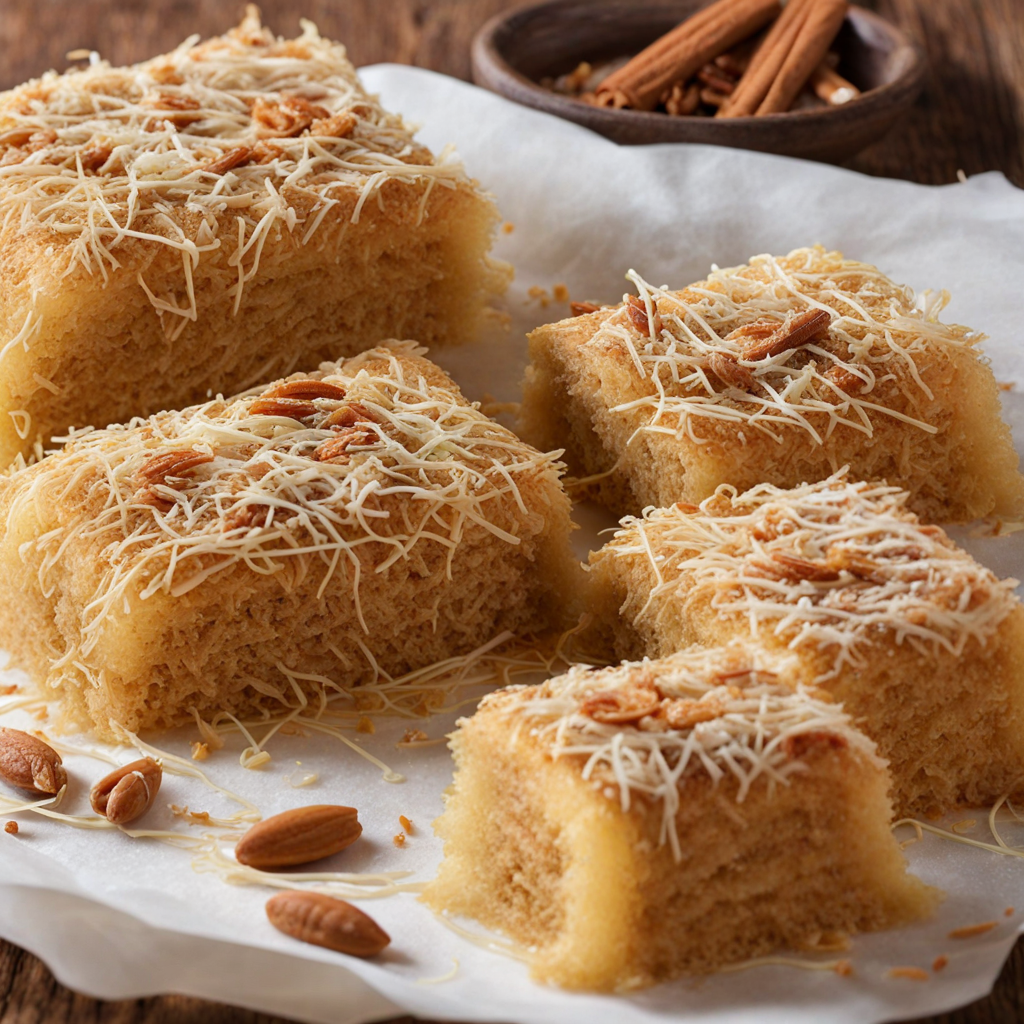Kataifi
Kataifi is a traditional dessert originating from the Middle Eastern region, particularly popular in Cyprus. This unique treat is made from shredded phyllo dough, resembling thin strands of angel hair pasta. The dough is expertly spun into delicate, fine strands, which are then layered and filled with a mixture of nuts, typically walnuts or pistachios, combined with fragrant spices such as cinnamon. The resulting texture is wonderfully crispy, offering a delightful contrast to the rich and nutty filling that lies within. Once assembled, Kataifi is generously drenched in a sweet syrup made from sugar, water, and lemon juice, allowing the flavors to meld beautifully. The syrup seeps into the layers, enhancing the sweet and nutty profile while maintaining the dessert's signature crunch. This combination of textures and flavors creates a symphony on the palate, with the sweetness of the syrup harmonizing perfectly with the toasted nuts and aromatic spices. Often served warm or at room temperature, Kataifi is a beloved dessert enjoyed during celebrations, holidays, and family gatherings in Cyprus. Its stunning appearance, with golden-brown strands cascading over the filling, makes it an enticing centerpiece for any table. As you take your first bite, you'll experience a delightful fusion of crispy, sweet, and nutty sensations, making Kataifi a must-try for anyone eager to explore new culinary delights.
How It Became This Dish
The History of Καταΐφι: A Culinary Treasure from Cyprus #### Origins Καταΐφι (kataifi) is a traditional Cypriot dessert that embodies the rich tapestry of the island's history, culture, and culinary art. Its origins are often traced back to the broader Middle Eastern and Mediterranean regions, where similar pastry techniques and ingredients are prevalent. The name "kataifi" itself is derived from the Arabic word "katayef," referring to a sweet pastry filled with nuts and drizzled with syrup. This connection to Arabic cuisine reflects the significant historical interactions between the peoples of the Eastern Mediterranean, including the Ottoman Empire, which ruled Cyprus for several centuries. The dish consists of a unique shredded phyllo pastry that resembles fine vermicelli or angel hair pasta. This innovative use of dough allows for a delightful texture that can be filled with various fillings, typically made from nuts like pistachios, walnuts, and almonds. The resulting pastry is then soaked in a sweet syrup, often flavored with rose or orange blossom water, enhancing its aromatic quality. The distinctiveness of kataifi lies in its versatility; it can be served as a dessert or enjoyed as a snack, making it a beloved staple in Cypriot households. #### Cultural Significance Throughout its history, kataifi has come to symbolize more than just a sweet treat in Cyprus; it represents the island's culinary heritage and the blending of cultures. The dessert is frequently associated with celebrations and special occasions, including weddings, religious holidays, and family gatherings. It is not uncommon to find kataifi served during Easter, Ramadan, and Christmas, highlighting its role in festive traditions. The preparation of kataifi is often a communal activity, bringing families and friends together. The intricate process of making the pastry and filling is typically passed down through generations, fostering a sense of continuity and cultural identity. For many Cypriots, the act of preparing kataifi is as significant as the dessert itself, serving as a means of storytelling and connecting with their ancestors. Moreover, kataifi's presence in the culinary landscape of Cyprus reflects the island's complex history of conquest, trade, and cultural exchange. The influence of Ottoman, Greek, and Middle Eastern cuisines can be seen not only in kataifi but also in other traditional dishes, showcasing the island's diverse gastronomic identity. #### Development Over Time The evolution of kataifi can be viewed through the lens of Cyprus's historical trajectory. During the Ottoman rule from the late 16th century until the late 19th century, the culinary arts flourished, and the integration of regional ingredients and techniques became more pronounced. This period marked the solidification of kataifi as a staple dessert, with its recipes being refined and adapted to local tastes. In the 20th century, as Cyprus underwent significant political and social changes, so too did its culinary practices. The island experienced a surge in national identity, particularly during the struggle for independence from British colonial rule. This awakening saw a revival of traditional foods, including kataifi, as symbols of national pride and cultural heritage. Cookbooks began to emerge, documenting traditional recipes and practices, ensuring that the legacy of dishes like kataifi would endure. Kataifi also adapted to the modern palate. Contemporary variations have emerged, incorporating ingredients such as chocolate or different flavored syrups, reflecting global culinary trends. Bakeries and restaurants across Cyprus now offer innovative takes on the classic dessert, making it accessible to a broader audience. Yet, despite these modern interpretations, the traditional recipe remains a cherished favorite among locals and visitors alike. The global diaspora of Cypriots has also played a significant role in the development and popularity of kataifi. As Cypriots migrated to different parts of the world, they brought their culinary traditions with them, introducing kataifi to new audiences. In cities with significant Cypriot populations, such as London, Sydney, and New York, kataifi can be found in specialty bakeries and restaurants, showcasing its enduring appeal and adaptability. #### The Modern Experience Today, kataifi is not only a symbol of cultural heritage but also a testament to the resilience and adaptability of Cypriot cuisine. The dessert remains a staple in both home kitchens and commercial establishments, a reminder of the island's rich history and the connections that bind its people. For visitors to Cyprus, tasting kataifi is an essential part of experiencing the island's culinary offerings, often served alongside strong coffee or herbal tea, further enhancing its enjoyment. In contemporary Cypriot society, there is a growing emphasis on preserving traditional food practices. Culinary schools and workshops are increasingly focused on teaching the art of making kataifi, ensuring that future generations will continue to appreciate and celebrate this exquisite dessert. Additionally, food festivals throughout Cyprus often feature kataifi, allowing both locals and tourists to engage with this beloved dish on a meaningful level. The continued evolution of kataifi serves as a reflection of Cyprus's dynamic food culture, where tradition meets innovation. The pastry has not only stood the test of time but has also thrived amidst changing culinary landscapes, affirming its place in the hearts of those who call the island home. Conclusion In conclusion, Καταΐφι is much more than just a dessert; it is a story woven into the fabric of Cypriot culture. Its origins, cultural significance, and development over time speak to the complexity and richness of the island's history. As Cypriots continue to embrace and celebrate their culinary heritage, kataifi stands as a testament to the enduring power of food as a means of connection, identity, and tradition. Whether enjoyed at a family gathering, a festive celebration, or a local bakery, kataifi remains a delicious reminder of Cyprus's vibrant past and promising future.
You may like
Discover local flavors from Cyprus







